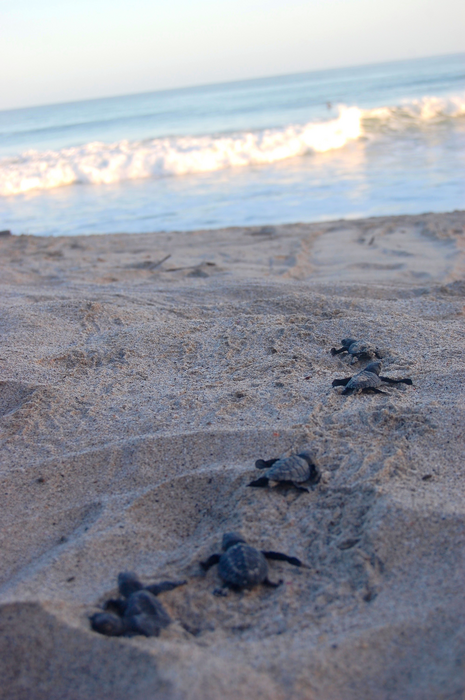A new low-cost sensor designed to resemble a sea turtle egg enables scientists to monitor nests remotely and predict when hatchlings will emerge almost to the day – providing valuable information for conservation efforts and turtle nest management. Erin Clabough of the University of Virginia and Samuel Wantman of Nerds Without Borders led the research, which publishes on October 26 in the open-access journal PLOS ONE.

Credit: Erin Clabough, CC-BY 4.0 (https://creativecommons.org/licenses/by/4.0/)
A new low-cost sensor designed to resemble a sea turtle egg enables scientists to monitor nests remotely and predict when hatchlings will emerge almost to the day – providing valuable information for conservation efforts and turtle nest management. Erin Clabough of the University of Virginia and Samuel Wantman of Nerds Without Borders led the research, which publishes on October 26 in the open-access journal PLOS ONE.
Sea turtle populations worldwide are in decline due to human activities, with Loggerhead, Green, Hawksbill, Kemp’s Ridley, Leatherback and Olive Ridley sea turtles all listed as threatened species. Sea turtle conservation efforts largely focus on protecting vulnerable hatchlings once they emerge, to ensure they head out to sea, instead of toward the bright lights of towns. Conservationists can count the days since eggs were laid to predict when they will hatch and then watch the nest, but these efforts are inaccurate and labor-intensive.
In the current study, researchers used the TurtleSense system to monitor loggerhead sea turtle nests on Cape Hatteras National Seashore to see if they could predict more accurately when the turtles would emerge from the nest. They buried an egg-sized sensor within the nest and attached a cable to a communication tower that remotely transmitted data on the movement of hatchlings within the nest.
The researchers identified a pattern of intense hatchling movement within the nest, followed by a pause, which let them predict almost the exact day when the young turtles would dig out of the sand. Their results suggest that hatchlings can detect motion, which allows them to communicate and head out together as a group. The system also accurately identified non-viable nests where monitoring was no longer necessary.
The new TurtleSense system has the potential to reduce the cost and labor required to monitor endangered turtle nests and to help conservationists make better decisions about nest management. The system can also shorten beach closures and enable communities to engage in turtle-based ecotourism, benefiting both the community and sea turtle conservation efforts. While this study focused on Loggerhead turtles, the researchers also monitored Olive Ridley and Green Turtle nests and saw similar patterns, suggesting that the system will work for a range of sea turtle species.
Erin Clabough adds: “It’s absolutely magical to witness baby turtles poke their heads out of the sand and sprint towards the ocean, but it’s an event that can be very hard to predict. The TurtleSense system is a low-cost, creative solution that remotely allows us to detect how baby turtles synchronize developmental movement within the nest in real time. We can use the system to detect hatching and to better predict when the hatchlings will emerge onto the beach.”
Samuel Wantman adds: “As each turtle emerges from its shell, it climbs up to join its siblings at the top of the clutch of eggs, creating a wave of commotion among all the other baby turtles in the nest. When there is no more commotion there is a period of quiet, which may be the impetus for all the hatchlings to boil out of the nest together.”
#####
In your coverage please use this URL to provide access to the freely available article in PLOS ONE: https://journals.plos.org/plosone/article?id=10.1371/journal.pone.0275088
Citation: Clabough EBD, Kaplan E, Hermeyer D, Zimmerman T, Chamberlin J, Wantman S (2022) The secret life of baby turtles: A novel system to predict hatchling emergence, detect infertile nests, and remotely monitor sea turtle nest events. PLoS ONE 17(10): e0275088. https://doi.org/10.1371/journal.pone.0275088
Author Countries: USA
Funding: This work was supported by volunteer work, donations, and by agreements listed in the acknowledgments section between the Hatteras Island Ocean Center nonprofit and the National Park Service. This work was also supported by the Virginia Foundation for Independent Colleges in the form of a grant awarded to EC. This works was also supported by the Hampden-Sydney Honors Program in the form of a grant awarded to JC.
Journal
PLoS ONE
DOI
10.1371/journal.pone.0275088
Method of Research
Observational study
Subject of Research
Animals
Article Title
The secret life of baby turtles: A novel system to predict hatchling emergence, detect infertile nests, and remotely monitor sea turtle nest events
Article Publication Date
26-Oct-2022
COI Statement
The authors have declared that no competing interests exist.


